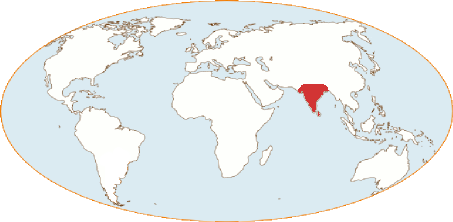Indian soma is a vegetal (fermented?) juice in the Vedic times.
In the Rigveda, Soma is at the same time a deity of vegetation (Vanaspati, Lord of Plants), a specific plant and a sacred beverage. Lord of plants and waters, king of the world, Soma refers to the essence of life and all that animates it. The soma-plant evokes an important acting power during sacrifice. Finally, soma is a beverage of immortality. The 9th cycle (mandala) of the Rigveda is entirely dedicated to the powers of Soma in the divine and earthly world. For the Vedas, Soma is a power manifested in 3 forms: divinity, plant, and beverage.
The preparation and use of the drink-soma are ritualised. Its consumption is reserved for priests and officiants. Its composition has given rise to numerous studies. Some see it as a sacred milk, others as a decoction of psychotropic plants, a wine or a beer. Soma comes from the juice of pressed plants. The plant is described as follows[1] :
"Vanaspati, the evergreen, the golden one, resplendent with a thousand branches " (RV IX.5.10). If the soma plant has no trunk, it is a bush or a grass. Soma has "yellow stems which immediately give the juice" (RV VIII.9.19). The plant described by the Rigveda has no leaves, flowers, fruits or roots. But the text never ceases to evoke its stem (amsú) and its bud/head (murdhan, siras). The branches or stems of soma are "very strong and armed with thorns so that not all bushes deceive Indra with their appearance" (RV X.89.5). The resistance of seeds or stems crushed between stones is indicated by the procedure "crushing the juice on the stone (produced) a celestial song that goes up to the sky" (RV X.76.6).
Some authors see in soma a kind of beer, because the Rig-Veda speaks of "mixing the thick juice extracted from the soma plant with barley flour" (RV IX.68.4). The clue is slim, as there is no evidence of alcoholic fermentation. The flour can be used as a thickener or softener to ingest a more or less vomiting plant juice.
A "very strong (intoxicating?) soma of 15 days" (RV X.27.2) indicates a ripening or a maturation, but without certainty a fermentation. The Rig-Veda does not attribute to the beverage-soma the effect of intoxicating liquor. It is not a censorship or a literary incapacity, because the Yajur-Veda describes in detail this drunkenness about the beer-sura (infra). This is the only indication of a possible fermentation, the duration of which reinforces the alcohol density. Two different terms qualify the power of the beverage. Soma produces máda (strength, visions, mental awakening), sura produces durmadh (drunkenness, intoxication, madness). "Indra drinks the juice of Soma which makes strong (máda) for great deeds" (RV I.56 .1). The second state of consciousness (drunkenness) is not the opposite of the first (exaltation). A "very strong soma" can mean a soma that becomes more energising or psychotropic after 15 days, instead of a very alcoholic soma.
Another hymn to Indra specifies that " drunkards do not praise with their (beer)-sura" (RV VIII.2. .12), which shows that the (beer)-sura is first of all intoxicating and nevertheless unfit for the worship of the god Indra[2]. It should be noted that the Rig-veda relates these two forms of mental states and modified behaviours (mental awakening vs inebriated madness) to the two different beverages (soma vs sura).
The "processed soma is red" (RV IX.82:1). Here soma does not refer to the beverage, but to the plant-soma which has yellow-red (orange?) inflorescences. In order to suggest that a beer-soma is brewed, this colour should be attributed to the red moulds which cover the amylolytic ferments. That would make soma a kind of millet or rice beer. Such red beers exist in Asia at that time, but in China, not in the western part of India as far as we know.
The beverage-soma probably has several ritual uses and therefore several compositions and processes. One of them may make soma a beer, but the evidence are scarce to date.
The Hymn to Indra, warrior god, makes the link between the agricultural wealth (the barley fields that must be harvested), the military conquests and the fermented beverages. This does not show that the beverage-soma is grain-based, fermented and alcoholic, but that beer-sura is admitted to the rank of ritual drinks or offerings dedicated to the god Indra. The warlike functions of Indra are expressed in particular by fury and overflowing, or it seems by the alcoholic drunkenness of its devotees as described by late texts of the brahmanic tradition.
[1] S. Mahdissan 1984, SOMA as Energizer-cum-euphoriant, versus SURA, an Intoxicant, Ancient Science of Life Vol No. III No. 3 January 1984 : 161 - 168. We follow Mahdissan's conclusions regarding the soma-drink as a euphoric and the beer-sura as an alcoholic beverage. But we do not follow other essays of Mahdissan, who sees beer-sura as a distilled alcohol and India as one of the countries of origin of alcoholic distillation. The textual clues given by Mahdissan are not conclusive. Nor do we take part in the debate on the identification of the botanical species of soma plant(s), a research too far away from the subjects dealt with in the history of beer.
[2] Unlike soma. The line continues " The naked man does not praise when it rains". Both soma and material wealth are necessary for humans to pray their gods. From this point of view, the alcoholic drunkenness given by the beer-sura is not the highest sort of blessing that humans expect from their gods.



